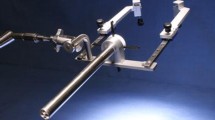Abstract
Background
To extend the usefulness of laparoscopic operations, a secure and easy method for the ligation of large vessels is needed. Herein we describe a novel ligation forceps that can be used as a ligature carrier and knot pusher.
Methods
A 2–0 suture thread with a knot already tied near one end is hooked in the upper jaw of a novel ligation forceps. After the lower jaw is passed under the vessel or cystic duct, the forceps is closed. When one end of the thread is withdrawn, the knot is trapped in the indentation built into the lower jaw; the ligature is then passed under the pedicle. An extracorporeal ligation can then be performed continuously by the same forceps.
Results
The origins of large vessels were ligated safely and easily with this device during 65 laparoscopic procedures (four total colectomies, 12 colectomies, and 49 gastrectomies). Following temporary hemostasis of accidental bleeding with clamping forceps, ligation hemostasis can also be performed using this instrument.
Conclusion
This novel ligation forceps permits the secure ligation of vessels or a cystic duct without the need for another device. The proposed method is both easy and inexpensive.
Similar content being viewed by others
References
Arnaud JP, Bergamaschi R (1993) Migration and slipping of metal clips after celioscopic cholecystectomy. Surg Laparosc Endosc 3: 487–488
Asao T, Hosouchi Y, Nakabayashi T, Haga N, Mochiki E, Kuwano H (2001) Laparoscopic-assisted total or distal gastrectomy with lymph node dissection for early gastric cancer. Br J Surg 88: 128–132
Bacha EA, Stieber AC, Galloway JR, Hunter JG (1994) Non-biliary complication of laparoscopic cholecystectomy. Lancet 344: 896–887
Ballesta Lopez C, Bastida Vila X, Catarci M, Mato R, Ruggiero R (1996) Laparoscopic Billroth II distal subtotal gastrectomy with gastric stump suspension for gastric malignancies. Am J Surg 171: 289–292
Jan YY, Chen HM, Wang CS, Chen MF (1997) Biliary complications during and after laparoscopic cholecystectomy. Hepatogastroenterology 44: 370–375
Lim BS (1996) Intracorporeal ligation of the cystic duct during laparoscopic cholecystectomy. Surg Laparosc Endosc 6: 388–391
Mann DV, Leow CK, Lai PB, Lau JW (1998) How to secure the cystic duct at laparoscopic cholecystectomy. Br J Surg 85: 345 [Letter]
Mansvelt B, Harb J, Farkas B, Mourou M, Huguet C (1993) “Clipstone” filiation within the biliary tract. Hepatobil Surg 6: 185–188
Nathanson LK, Easter DW, Cuschieri A (1991) Ligation of the structures of the cystic pedicle during laparoscopic cholecystectomy. Am J Surg 161: 350–354
Nicol DL, Winkle DC, Nathanson LK, Smithers BM (1994) Laparoscopic nephrectomy for benign renal disease. Br J Urol 73: 237–241
Nowzaradan Y, Meador J, Westmoreland J (1992) Laparoscopic management of enlarged cystic duct. Surg Laparosc Endosc 2: 323–326
Pasic R, Levine RL (1995) Laparoscopic suturing and ligation techniques. J Am Assoc Gynecol Laparosc 3: 67–79
Puttic MI, Nduka BA, Darzi A (1994) Extracorporeal knot tying using an atraumatic Babcock clamp. J Laparosc Surg 4: 339–341
Sharp HT, Dorsey JH, Chovan JD, Holtz PM (1996) A simple modification to add strength to the Roeder knot. J Am Assoc Gynecol Laparosc 3: 305–307
Targarona EM, Espert JJ, Balague C, Piulachs J, Artigas V, Trias M (1998) Splenomegaly should not be considered a contraindication for laparoscopic splenectomy. Ann Surg 228: 35–39
Thibault C, Poulin EC (1995) Total laparoscopic proctocolectomy and laparoscopy-assisted proctocolectomy for inflammatory bowel disease: operative technique and preliminary report. Surg Laparosc Endosc 5: 472–476
Woods MS, Shellito JL, Santoscoy GS, Hagan RC, Kilgore WR, Traverso LW, Kozarek RA, Brandabur JJ (1994) Cystic duct leaks in laparoscopic cholecystectomy. Am J Surg 168: 560–563
Author information
Authors and Affiliations
Additional information
Online publication: 3 April 2001
Rights and permissions
About this article
Cite this article
Asao, T., Kuwano, H., Mochiki, E. et al. A novel ligation forceps can be used as a ligature carrier and knot pusher during laparoscopic surgery. Surg Endosc 15, 524–527 (2001). https://doi.org/10.1007/s004640080058
Received:
Accepted:
Published:
Issue Date:
DOI: https://doi.org/10.1007/s004640080058




